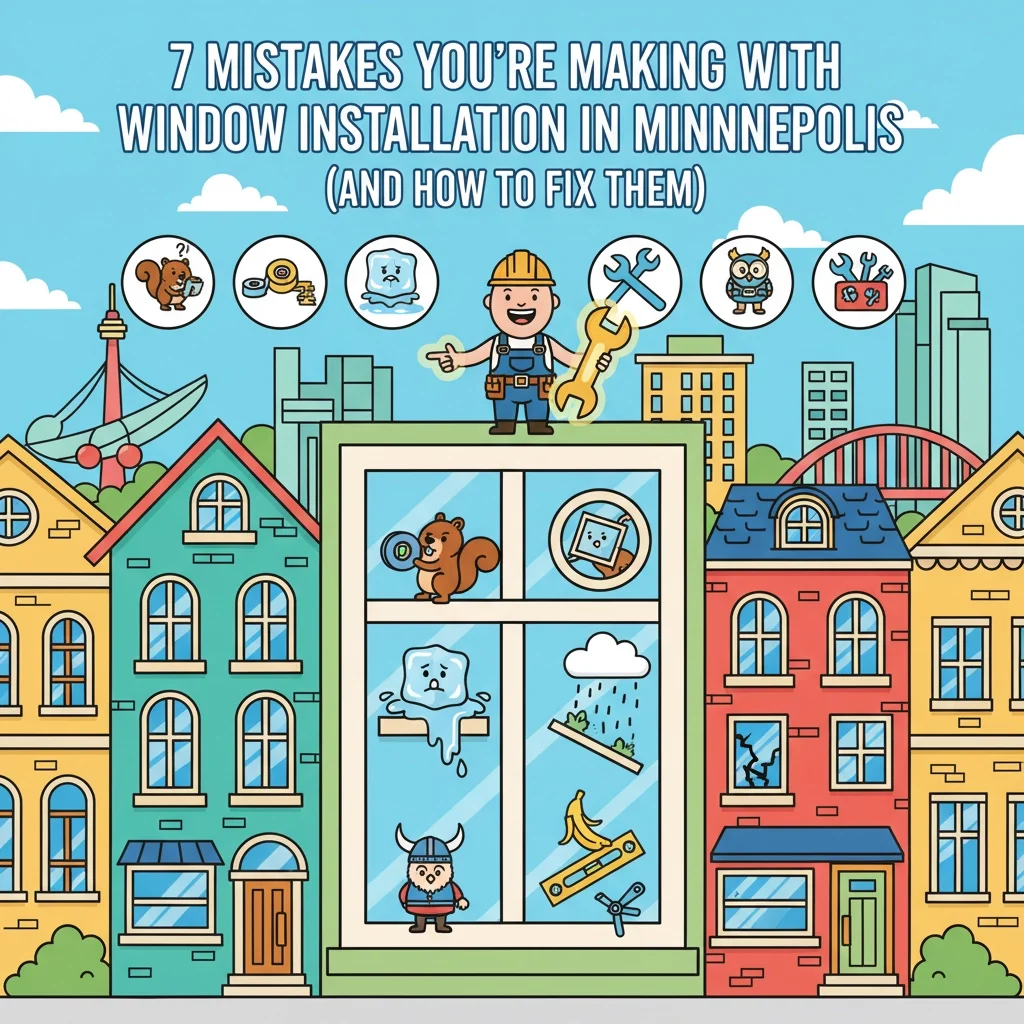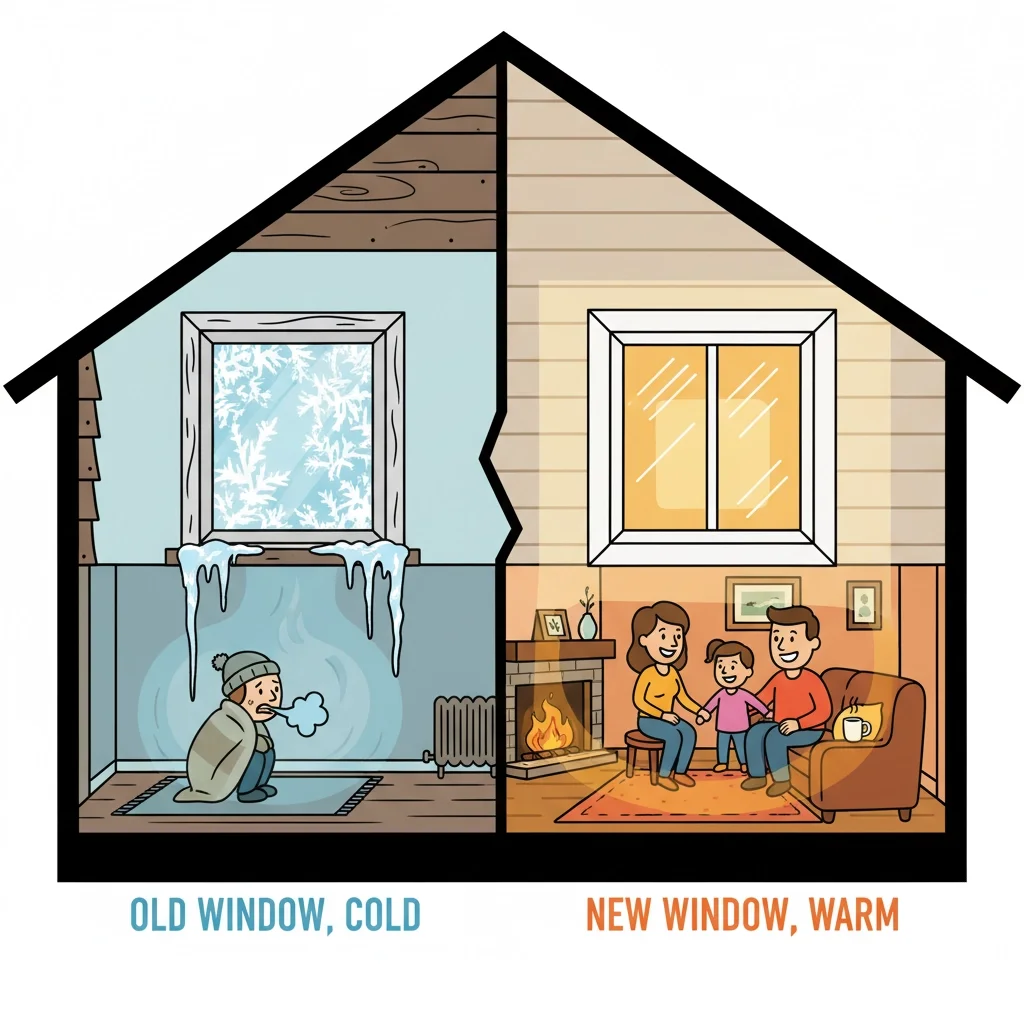7 Mistakes You're Making with Window Installation in Minneapolis (and How to Fix Them)
/Hey there, Minneapolis homeowners! Let's have an honest chat about window installation. You know that feeling when you're excited about upgrading your home's windows, only to discover six months later that something's gone terribly wrong? Maybe you're dealing with drafts that make your living room feel like an igloo, or worse, water damage creeping into your walls.
Trust me, we've seen it all. After years in the Twin Cities window business, I can tell you that most window installation problems aren't because of bad windows, they're because of avoidable mistakes during installation. The good news? Once you know what to watch out for, you can save yourself thousands in repairs and headaches.
Let's dive into the seven biggest mistakes Minneapolis homeowners make with window installation, and more importantly, how to fix them.
Mistake #1: Choosing the Wrong Window Type for Minnesota's Climate
Here's the thing about Minnesota weather, it's brutal. We're talking about temperature swings from -20°F in January to 90°F in July, plus all that lovely humidity in summer and bone-dry air in winter. Not all windows are built for this kind of punishment.
I see homeowners all the time who got excited about a "great deal" on windows, only to discover they picked single-pane or cheap double-pane windows that simply can't handle our climate. You end up with condensation between panes, drafts that make your heating bills skyrocket, and windows that expand and contract so much they won't open properly.
How to Fix It: Look for windows specifically designed for northern climates. You want triple-pane glass with low-E coatings and argon gas fills, yes, it sounds fancy, but it's essential here in Minnesota. The frame material matters too. Vinyl and fiberglass hold up better to our freeze-thaw cycles than wood or aluminum. Don't just shop price, shop for Minnesota-tough performance.
Mistake #2: DIY Installation Without Experience
I get it, YouTube makes everything look easy, and saving money on labor costs sounds appealing. But window installation isn't like hanging a picture frame. One small mistake in measurement, sealing, or leveling can create problems that cost way more than professional installation would have.
The biggest issue? Most DIYers don't understand the building science behind proper window installation. It's not just about making the window fit, it's about creating a weatherproof seal that manages moisture, prevents air leakage, and maintains structural integrity.
How to Fix It: Unless you have serious construction experience, leave window installation to the pros. A good installer brings years of experience, proper tools, and knowledge of local building codes. Plus, professional installation usually comes with warranties that protect your investment. When you factor in the cost of fixing DIY mistakes, professional installation often costs less in the long run.
Mistake #3: Ignoring Water Management (Improper Flashing & Sealing)
This is the big one, folks. Poor water management is behind most of the horror stories you hear about window installations gone wrong. In Minnesota, we deal with driving rain, snow buildup, ice dams, and spring melts. If your windows aren't properly flashed and sealed, all that water finds its way into your walls.
I've seen water damage that started with a small gap in window flashing and ended up requiring thousands in drywall, insulation, and structural repairs. The worst part? The damage often goes unnoticed until it's extensive.
How to Fix It: Proper flashing is non-negotiable. This means installing a sill pan under the window, using step flashing along the sides, and installing head flashing above. The flashing should direct water away from the building, not just seal it out. Quality sealants and weatherstripping are equally important, but they need to be applied correctly, in the right sequence, with the right materials.
Mistake #4: Not Measuring Properly
"Measure twice, cut once" isn't just a saying, it's survival advice for window installation. Even being off by 1/4 inch can create gaps that let in air and water. But here's what most people don't realize: measuring for windows isn't just about height and width.
You need to account for the depth of your wall construction, any irregularities in the opening (old houses rarely have perfectly square openings), and the specific requirements of your chosen window style. I've seen installations where the measurements were "close enough", and the homeowner ended up with drafts, operational problems, and a window that looked awkward.
How to Fix It: Measure height, width, and depth at multiple points, windows openings aren't always perfectly square or level. Take measurements from both inside and outside if possible. For replacement windows, you also need to account for existing trim and interior finishes. When in doubt, have a professional measure, most reputable companies offer free measurements because they know accurate measurements are crucial for a successful installation.
Mistake #5: Hiring Unqualified or Unlicensed Installers
I know, I know, that guy who knocked on your door after the last storm offered to do your windows for half the price of licensed contractors. But here's the reality: window installation requires specific skills, proper tools, and knowledge of local building codes. Unlicensed installers often lack insurance, warranties, and accountability.
The horror stories are real: windows installed upside down, improper sealing that leads to leaks, structural damage from cutting into load-bearing elements, and installations that don't meet code requirements. When problems arise, unlicensed contractors often disappear, leaving homeowners holding the bag.
How to Fix It: Always verify that your installer is licensed, bonded, and insured. Check references and read reviews from multiple sources. A legitimate contractor will happily provide proof of licensing and insurance. They should also offer warranties on their work and be available for follow-up service. Yes, licensed contractors cost more upfront, but they save you money and headaches in the long run.
Mistake #6: Skipping the Permit and Inspection
"It's just a window replacement, do I really need a permit?" The answer in Minneapolis is often yes, especially for full window replacements. Skipping permits might seem like a time and money saver, but it can create serious problems down the road.
Building codes exist for good reasons, especially in Minnesota where proper installation is crucial for energy efficiency and weather resistance. Plus, unpermitted work can create issues when you sell your home or file insurance claims.
How to Fix It: Check with the City of Minneapolis building department about permit requirements for your specific project. Most window replacements require permits, and the inspection process helps ensure the work is done correctly. A reputable contractor will handle the permit process for you and actually welcome inspections because they're confident in their work quality.
Mistake #7: Neglecting the Finish Work (Insulation & Trim)
The window is installed and it looks great from the outside, so you're done, right? Wrong. The finish work: proper insulation around the frame, interior and exterior trim, and final sealing: is just as important as the window installation itself.
I see this mistake all the time: homeowners or installers rush through the finish work, leaving gaps that compromise energy efficiency and allow moisture infiltration. Poor trim work also affects both the appearance and performance of your new windows.
How to Fix It: Use low-expansion foam insulation around the window frame, but don't overdo it: too much foam can bow the frame and affect window operation. Install proper interior and exterior trim that seals gaps and directs water away from the window. Pay attention to caulking details: use high-quality exterior caulk that can handle Minnesota weather extremes. The finish work should be as carefully planned and executed as the window installation itself.
The Bottom Line for Minneapolis Homeowners
Look, window installation isn't rocket science, but it does require knowledge, experience, and attention to detail. These seven mistakes might seem minor individually, but they add up to major problems: higher energy bills, water damage, reduced comfort, and decreased home value.
The good news? Now that you know what to watch out for, you can avoid these costly mistakes. Whether you're planning a DIY project (though I'd strongly recommend reconsidering) or hiring professionals, keep these points in mind.
And remember, in Minnesota's challenging climate, quality installation isn't just about today's comfort: it's about protecting your investment for years to come. Don't let these common mistakes turn your window upgrade into a costly nightmare.
Ready to do your window project right the first time? Learn more about choosing the best windows for Minnesota homes or discover if it's time to replace your old windows.
Stay warm, Minneapolis!






